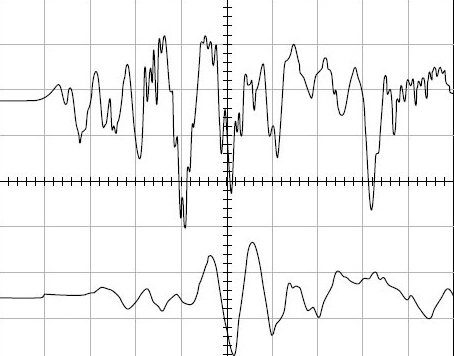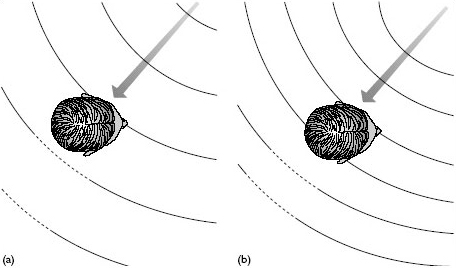1.2 Disentangling sounds
If you are still feeling aggrieved about the shortcomings of evolution, then you might take heart from the remarkable way in which the auditory system has evolved so as to avoid a serious potential problem. Unlike our eyes, our ears cannot be directed so as to avoid registering material that we wish to ignore; whatever sounds are present in the environment, we must inevitably be exposed to them. In a busy setting such as a party we are swamped by simultaneous sounds – people in different parts of the room all talking at the same time. An analogous situation for the visual system would be if several people wrote superimposed messages on the same piece of paper, and we then attempted to pick out one of the messages and read it. Because that kind of visual superimposition does not normally occur, there have been no evolutionary pressures for the visual system to find a solution to the problem (though see below). The situation is different with hearing, but the possession of two ears has provided the basis for a solution.

Figure 1 shows a plot of sound waves recorded from inside a listener's ears. You can think of the up and down movements of the wavy lines as representing the in and out vibrations of the listener's ear drums. The sound was of a single hand clap, taking place to the front left of the listener. You will notice that the wave for the right ear (i.e. the one further from the sound) comes slightly later than the left (shown by the plot being shifted to the right). This right-ear plot also goes up and down far less, indicating that it was less intense, or in hearing terms that it sounded less loud at that ear. These differences, in timing and intensity, are important to the auditory system, as will be explained.

Figure 2a represents sound waves spreading out from a source and passing a listener's head. Sound waves spread through the air in a very similar way to the waves (ripples) spreading across a pond when a stone is thrown in. For ease of drawing, the figure just indicates a ‘snapshot’ of the positions of the wave crests at a particular moment in time. Two effects are shown. First, the ear further from the sound is slightly shadowed by the head, so receives a somewhat quieter sound (as in Figure 1). The head is not a very large obstacle, so the intensity difference between the ears is not great; however, the difference is sufficient for the auditory system to register and use it. If the sound source were straight ahead there would be no difference, so the size of the disparity gives an indication of the sound direction. The figure also shows a second difference between the ears: a different wave part (crest) has reached the nearer left ear than the further right ear (which is positioned somewhere in a trough between two peaks). Once again, the inter-aural difference is eliminated for sounds coming from straight ahead, so the size of this difference also indicates direction.
Why should we make use of both intensity and wave-position differences? The reason is that neither alone is effective for all sounds. I mentioned that the head is not a very large obstacle; what really counts is how large it is compared with a wavelength. The wavelength is the distance from one wave crest to the next. Sounds which we perceive as low pitched have long wavelengths – longer in fact than the width of the head. As a result, the waves pass by almost as if the head was not there. This means that there is negligible intensity shadowing, so the intensity cue is not available for direction judgement with low-pitched sounds. In contrast, sounds which we experience as high pitched (e.g. the jingling of coins) have wavelengths that are shorter than head width. For these waves the head is a significant obstacle, and shadowing results. To summarise, intensity cues are available only for sounds of short wavelength.
In contrast to the shadowing effect, detecting that the two ears are at different positions on the wave works well for long wavelength sounds. However, it produces ambiguities for shorter waves. The reason is that if the wave crests were closer than the distance from ear to ear, the system would not be able to judge whether additional waves should be allowed for. Figure 2b shows an extreme example of the problem. The two ears are actually detecting identical parts of the wave, a situation which is normally interpreted as indicating sound coming from the front. As can be seen, this wave actually comes from the side. Our auditory system has evolved so that this inter-ear comparison is made only for waves that are longer than the head width, so the possibility of the above error occurring is eliminated. Consequently, this method of direction finding is effective only for sounds with long wavelengths, such as deeper speech sounds.
You will notice that the two locating processes complement each other perfectly, with the change from one to the other taking place where wavelengths match head width. Naturally occurring sounds usually contain a whole range of wavelengths, so both direction-sensing systems come into play and we are quite good at judging where a sound is coming from. However, if the only wavelengths present are about head size, then neither process is fully effective and we become poor at sensing the direction. Interestingly, animals have evolved to exploit this weakness. For example, pheasant chicks (that live on the ground and cannot fly to escape predators) emit chirps that are in the ‘difficult’ wavelength range for the auditory system of a fox. The chicks’ mother, with her bird-sized head, does not have any problems at the chirp wavelength, so can find her offspring easily. For some strange reason, mobile telephone manufacturers seem to have followed the same principle. To my ears they have adopted ringtones with frequencies that make it impossible to know whether it is one's own or someone else's phone which is ringing!
Activity 1
Set up a sound source (the radio, say), then listen to it from across the room. Turn sideways-on, so that one ear faces the source. Now place a finger in that nearer ear, so that you can hear the sound only via the more distant ear. You should find that the sound seems more muffled and deeper, as if someone had turned down the treble on the tone control. This occurs because the shorter wavelength (higher pitched) sounds cannot get round your head to the uncovered ear. In fact you may still hear a little of those sounds, because they can reflect from the walls, and so reach your uncovered ear ‘the long way round’. Most rooms have sufficient furnishings (carpets, curtains, etc.) to reduce these reflections, so you probably will not hear much of the higher sounds. However, if you are able to find a rather bare room (bathrooms often have hard, shiny surfaces) you can use it to experience the next effect.
Do the same as before, but this time you do not need to be sideways to the sound. If you compare your experiences with and without the finger in one ear you will probably notice that, when you have the obstruction, the sound is more ‘boomy’ and unclear. This lack of clarity results from the main sound, which comes directly from the source, being partly smothered by slightly later echoes, which take longer routes to your ear via many different paths involving reflections off the walls etc. These echoes are still there when both ears are uncovered, but with two ears your auditory system is able to detect that the echoes are coming from different directions from the main sound source, enabling you to ignore them. People with hearing impairment are sometimes unable to use inter-aural differences, so find noisy or echoing surroundings difficult.
